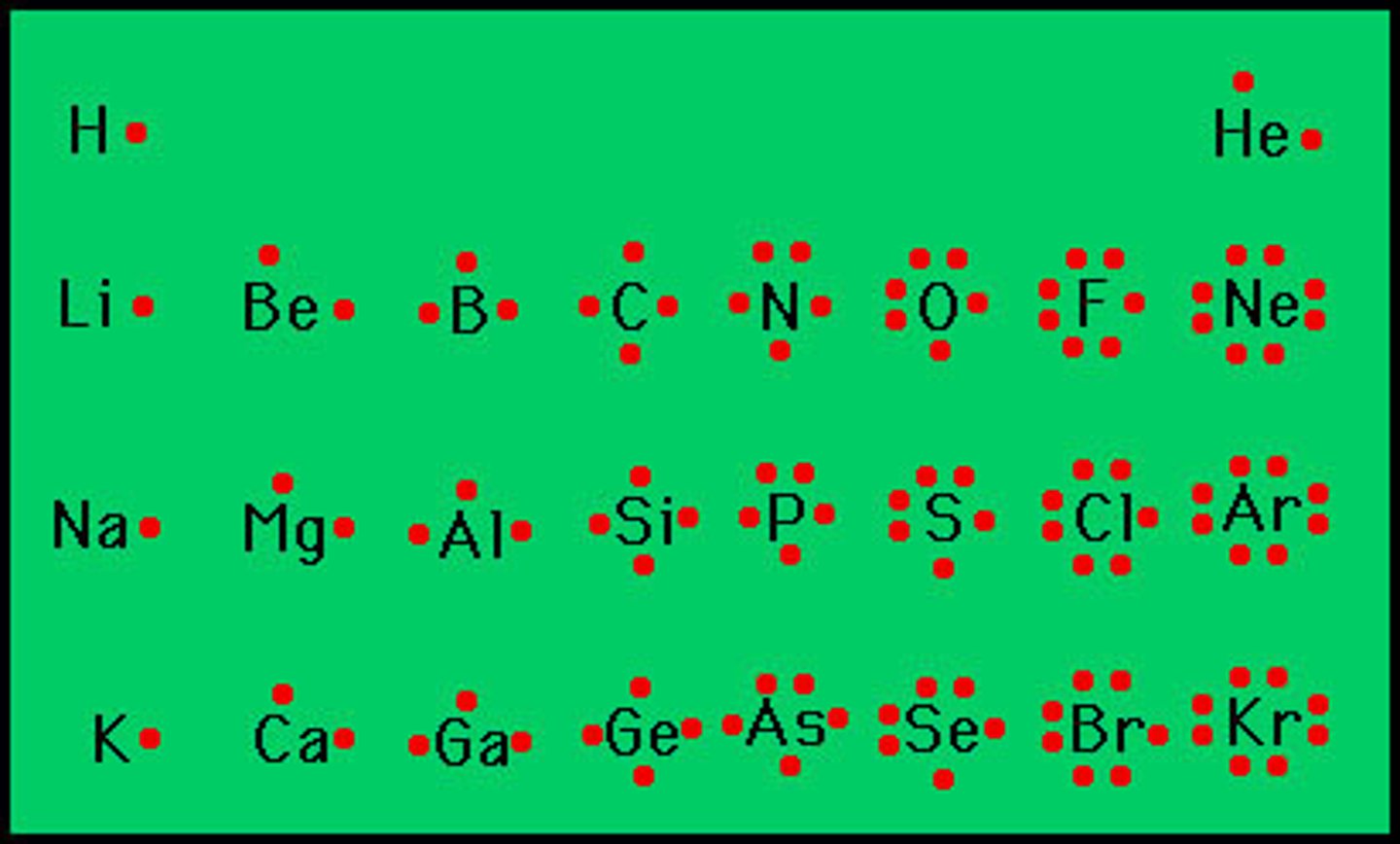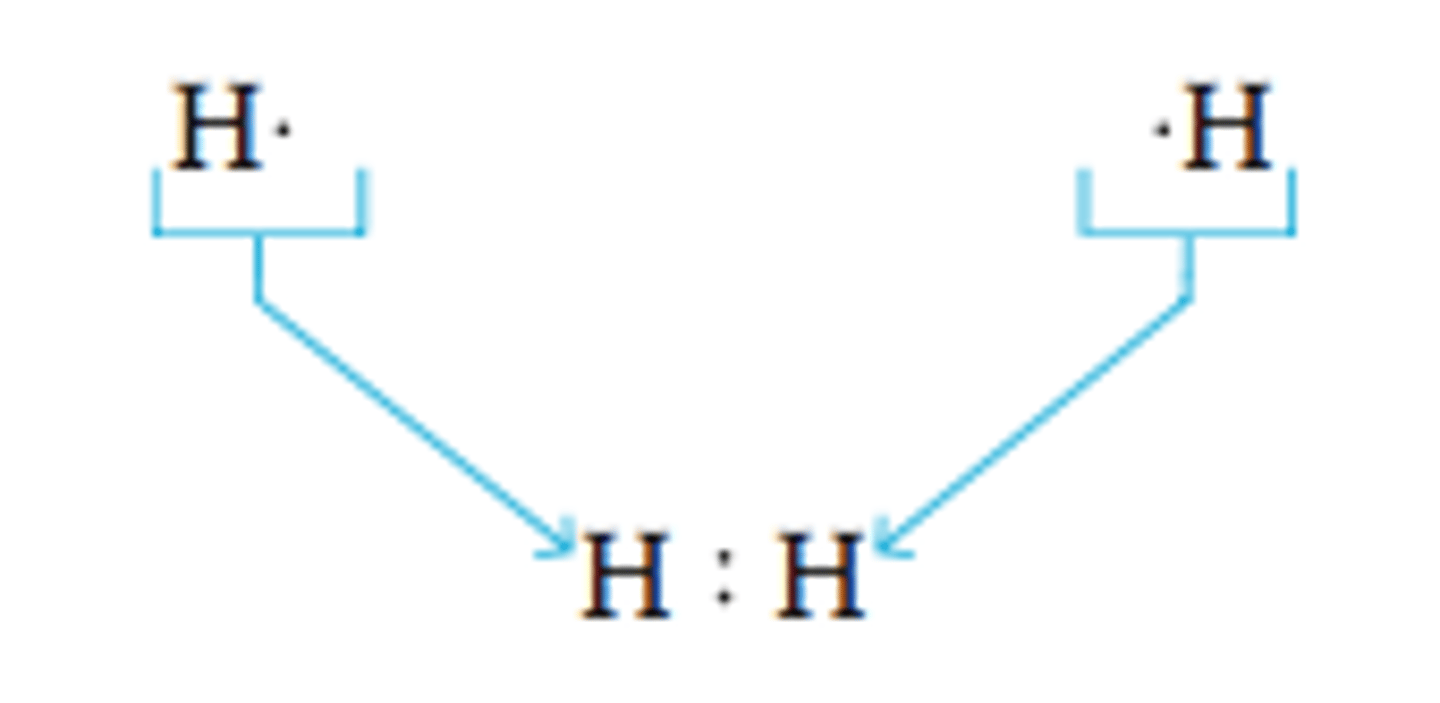Chapter 10: Lewis structures, Polarity
1/39
There's no tags or description
Looks like no tags are added yet.
Name | Mastery | Learn | Test | Matching | Spaced |
|---|
No study sessions yet.
40 Terms
Lewis Model
A simple model for a chemical bond in which atoms transfer or share electrons to attain a noble gas electron configuration (usually referred to as an octet)
-In this model, we represent electrons as dots and draw dot structures or Lewis structures to represent molecules
Lewis Structure
A drawing that represents chemical bonds between atoms as shared or transferred electrons; the valence electrons of atoms are represented as dots
How to draw a Lewis Dot Structure
Each dot represents a valence electron. We place the dots around the element's symbol with a maximum of two dots per side. Although the exact location of dots is not critical, in this book we fill in the dots singly first and then pair them

Octet
In Lewis structures, the goal is to make almost all atoms have this structure. This means they will have access to (8) electrons regularly, even if they do have to share some of them
-The number of electrons, 8, around atoms with stable Lewis structures
-The octet rule generally applies to all main-group elements except hydrogen and helium. Each of these elements achieves stability when it has two electrons (a duet) in its outermost shell.
Duet
The name for the two electrons corresponding to a stable Lewis structure in Hydrogen and Helium

Write a Lewis structure for each of the following ion, show the formal charge:
N3-
Normally N has 5 electrons but since it has a 3- charge we add 3 more electrons which totals them to 8 electrons.
So, all 8 dots go on N and we place this in brackets with a 3- charge outside the bracket
Chemical bond
The sharing or transfer of electrons to attain stable electron configurations for the bonding atoms
Ionic bond
If the electrons are transferred in a chemical bond it is an ionic bond
-The bond that results when a metal and a nonmetal combine in a chemical reaction, in an ionic bond, the metal transfers one or more electrons to the nonmetal
When an ionic bond forms between two atoms what is the general form of their Lewis structure?
The cations keep their new charge and the anions keep their dot structure & their new charges are also included
If we take K an Cl as an example
K has one dot on its Lewis structure and Cl has 7 dots
When they bond, K's dot is replaced with a plus sign since it lost an electron and Cl forms its octet (has 8 dots around it now) and is placed in brackets with its new charge, minus 1.
covalent bond
If the electrons are shared in a chemical bond it is a covalent bond
-The bond that results when two nonmetals combine in a chemical reaction. In a covalent bond, the atoms share their electrons
Terminal atom
an atom that is located at the end of a molecule or chain
ex: H2O -----> HOH The H are not the central atoms, hydrogen atoms are always terminal
-We put the less metallic elements in terminal positions
-Many molecules tend to be symmetrical, so when a molecule contains several atoms of the same type, these tend to be in terminal positions
covalent =
ionic=
share
transfer
Determine whether each of the following compounds would be best represented by an ionic or a covalent Lewis structure.
1)SF6
2)MgCl2
1) Covalent; F has 7 atoms who need 1 electron and S needs 2 there is no clear electron transfer plan so most likely the electrons need to be shared
2) Ionic; since Mg has two spare electrons and Cl needs 1 electron so we add another Cl to make the transfer complete
Use Lewis theory to determine the formula for the compound that forms from Mg and Br
If we draw the Lewis dot structure for Mg and Br we see that Br only needs 1 more electron to get its octet and Mg needs to get rid of 2 electrons to achieve its octet. So if we get 2 Br's then Mg can give 1 electron to each Br. Thus the chemical formula is MgBr2
bonding pair
Electrons that are shared between two atoms in a chemical bond
Lone pair
Electrons that are only on one atom in a Lewis structure
single bonds
the sharing of one pair of electrons between two atoms
double bonds
the sharing of two pairs of electrons between two atoms
-The bond that exists when two electron pairs are shared between two atoms. In general, double bonds are shorter and stronger than single bonds
triple bonds
A chemical bond formed when atoms share three pairs of electrons
-Triple bonds are shorter and stronger than double bonds
Steps for Writing Lewis Structures
1. Write the correct skeletal structure for the molecule
2. Calculate the total number of electrons for the Lewis structure by summing the valence electrons of each atom in the molecule (If you are writing a Lewis structure for a polyatomic ion, you must consider the charge of the ion when calculating the total number of electrons)
3. Distribute the electrons among the atoms, giving octets (and duets for Hydrogen) to as many atoms as possible
4. if any atoms lack an octet, form double or triple bonds as necessary to give them octets
OH- Lewis structure
8 Total electrons
6 left over to form octets
O-H O gets those 6 electrons and H is fine with the single bond
NH4+ Lewis structure
Remember that a plus sign means there is one LESS electron So its 5+4(1)-1=8 electrons
N will have a 4 H's attached to it, the single bonds should be enough for H and N forms an octet
Exceptions to the Octet Rule
B: likes to have 3 bonds and only 6 e's
NO: exists having a double bond between them, O has 4 electrons and forms its octet and N only has 3 electrons around it, it does not form an octet
Additionally, a number of molecules have more than 8 electrons around a central atom in their Lewis structures, these are referred to as expanded octets
Resonance Structures
structures that occur when it is possible to draw two or more valid electron dot structures that have the same number of electron pairs for a molecule or ion
-The molecule exists in nature as an average of intermediate between the two Lewis structures
How do we represent resonance structures?
We draw all the possible outcomes with a double sided arrow between them
Valence-shell electron-pair repulsion theory (VSEPR theory)
A theory that allows prediction of the shapes of molecules based on the idea that electrons-either as lone pairs or as bonding pairs-repel one another
Electron group
A general term for a lone pair, single bond, or multiple bond in a molecule
electron geometry
the geometrical arrangement of electron groups in a molecule
molecular geometry
The geometrical arrangement of the atoms in a molecule
VSEPR- 2 electron groups
-𝐋𝐢𝐧𝐞𝐚𝐫 (Electron geometry=Molecular geometry)
-180 degrees
Describes the molecular geometry of a molecule containing two electron groups (two bonding groups and no lone pairs)
VSEPR- 3 Electron groups
-𝐓𝐫𝐢𝐠𝐨𝐧𝐚𝐥 𝐏𝐥𝐚𝐧𝐚𝐫 (Electron geometry for both cases)
-120 degrees
-If one of the 3 electron groups includes a lone pair than the molecule is 𝐁𝐞𝐧𝐭 (molecular geometry)
VSEPR- 4 Electron groups
-𝐓𝐞𝐭𝐫𝐚𝐡𝐞𝐝𝐫𝐚𝐥 (Electron geometry for all 3 cases)
-109.5 degrees
-If one of the 4 electron groups includes 1 lone pair than the molecule is 𝐓𝐫𝐢𝐠𝐨𝐧𝐚𝐥 𝐏𝐲𝐫𝐚𝐦𝐢𝐝𝐚𝐥 (molecular geometry)
-If one of the 4 electron groups includes 2 lone pairs than the molecule is 𝐁𝐞𝐧𝐭 (molecular geometry)
Electronegativity
The ability of an element to attract electrons within a covalent bond
dipole moment
a separation of charge within a chemical bond that produces a bond with a positive end and a negative end
-Since the electron pair is unequally shared (with oxygen getting the larger share), the oxygen atom has a partial negative charge, symbolized by δ− (delta minus). The hydrogen atom (which gets the smaller share) has a partial positive charge, symbolized by δ+ (delta plus). The result of this uneven electron sharing is a dipole moment
-The magnitude of the dipole moment, and therefore the degree of polarity of the bond, depend on the electronegativity difference between the two elements in the bond and the length of the bond. For a fixed bond length, the greater the electronegativity difference, the greater the dipole moment and the more polar the bond.
Polar covalent bonds
A covalent bond between atoms of different electronegativities. Polar covalent bonds have a dipole moment
nonpolar (Pure) covalent bond
A covalent bond in which the electrons are shared equally by the two atoms and does not have a dipole moment
AKA pure covalent bond if electronegativity is between 0-0.4
Ionic Bond
If there is a large electronegativity difference between the two elements in a bond, such as normally occurs between a metal and a nonmetal, the electron is completely transferred and the bond is ionic. For example, sodium and chlorine form an ionic bond
Polar covalent
If there is an intermediate electronegativity difference between the two elements, such as between two different nonmetals, the bond is polar covalent. For example, HF forms a polar covalent bond
Polar Molecule
a molecule with polar bonds that add together to create a net dipole moment
For example, consider carbon dioxide: Each C═O bond is polar because the difference in electronegativity between oxygen and carbon is 1.0. However, since CO2 has a linear geometry, the dipole moment of one bond completely cancels the dipole moment of the other and the molecule is nonpolar
Common Cases of Adding Dipole Moments to Determine Whether a Molecule Is Polar
NonPolar: Linear, Trigonal planar, Tetrahedral
-These all have bonds that cancel one another since they are identical
Polar: Bent and Trigonal Pyramidal
-Since the bonds are not identical, the bonds don't cancel each other out